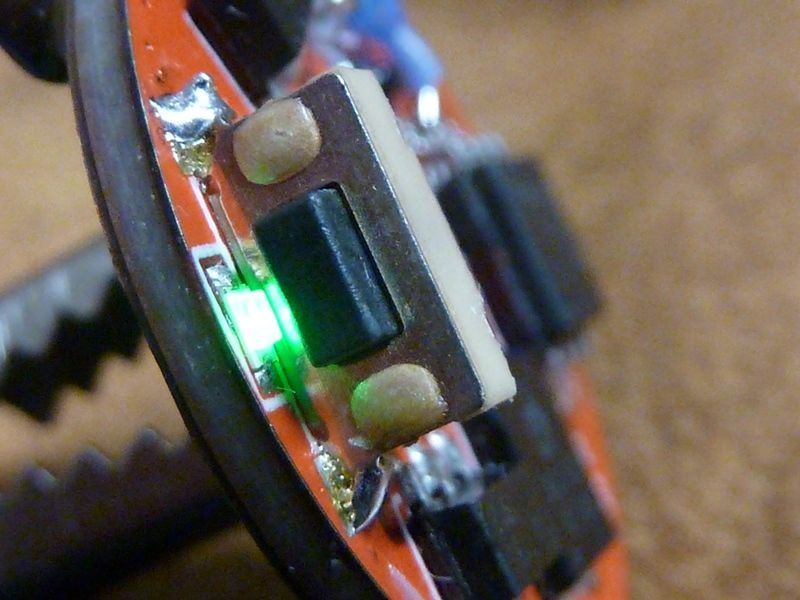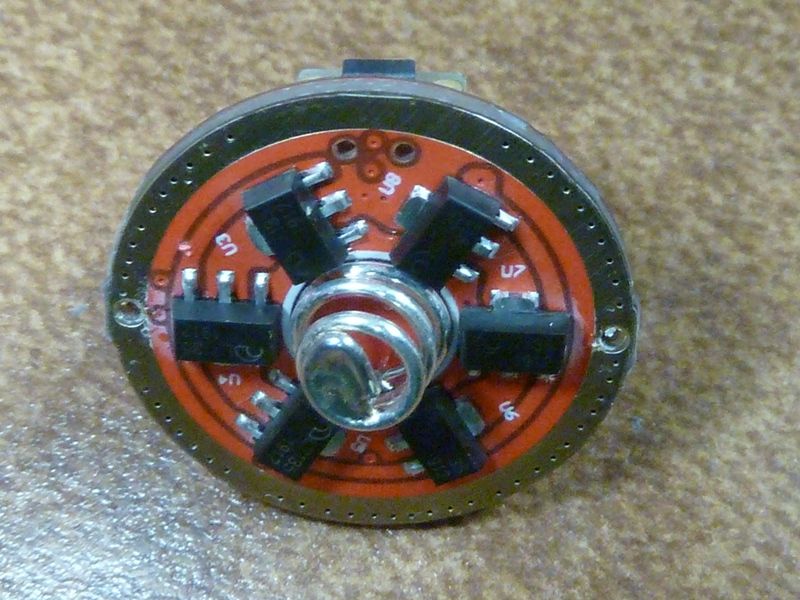It would help to say whereabouts in the world you are.
US. Lower 48. TN
Finally got up enough courage and set aside enough time to install the FW3X-Lume1 driver and Aux Board. Glad I did not rush because this was honestly one of the more taxing installs I’ve tackled. Everything is tight and small.
Thanks to the advice, observations and installation tips of folks on this thread it probably went better than if I had not followed their footsteps. So here too are my experiences.
(1) As received the Aux board emitter holes didn’t align with the installed LEDs (XP-L HI’s). Being a triple, I expected as much. Fortunately, there was enough space around the Aux circuit board that I was able to enlarge the holes and manage to get the Aux board over all three emitters.
[Before Adjustment, Aux wouldn’t site flat because emitter holes didn’t align]

[After some filing, fits flush to MCPCB surface]

(2) My previous mod experience has always involved upsizing wires, so I didn’t have any smaller than 24 gauge for the Aux wiring. I purchased some high temperature 28 gauge for the occasion. Rather than purchase a variety of colors, I got plain white and colored the tips RBG to help with install.


(3) Swapping the teeny tiny resistors was an exercise in patience. At one point I lost one of the resistors and spent 15 minutes searching for something the size of a grain of salt. (Actually, I think salt’s bigger.)
Decided to go -
- Red 220 Ohm
- Green 330 Ohm
- Blue 100 Ohm
I think the light levels came out fairly even across the three colors (same manual camera exposure levels, for comparison purposes)
 Red
Red  Green
Green
 Blue
Blue  Magenta
Magenta
 Yellow
Yellow  Cyan
Cyan
And almost forgot, presumable the RGB blended White
 White
White  (White. diffused)
(White. diffused)
Thanks to Loneoceans for sharing the Buck-Boost Driver and Aux designs with us, and thanks to NealsGadgets for making them available.
Edited to add Aux RGB White combo and references to original resistor values.
I’d love this, I got a sofirn IF25 with tint ramping where I replaced the LEDs with sliced LH351d and I really like the ability to choose the color temperature, with the bonus of CCT mixing improving the tint and increasing color saturation. The host and driver aren’t particularly great though, not very efficient and lacking proper thermal regulation, an efficient 2 channels anduril driver would be much better.
JaredM mentionned Clemence and Skilhunt, as far as I know Skilhunt doesn’t chase high lumens with insane turbos and they typically use buck or boost drivers.
So this came out a lot less helpful than I imagined but I recorded it so I might as well upload it. Trying to solder backwards facing the camera was even more difficult than I imagined so there are mistakes. Also, I would suggest going to youtube and making sure it’s in 1080p so you can better see me screw up.
Thanks for the tips, the helps, and the videos for the assembly. I was able to swap the driver with Lume1 along with AUX board. I chose the resistors of 1.8K for Red and Blue and 5.6K for Green, the recommended values. I am happy with these values. The low level is very dim, almost like trit. The high is bright enough. I think the disadvantage with these values is the color mixing to obtain the color somewhere in between like yellow, violet, white, and so on. Those in-between colors are not defined well. I can see red and blue clearly for violet, for example.
Everything seems to be working. I have got several questions, but I will start with those next.
The AUX LED’s have the selections of R, Y, G, C, B, V, W, Rainbow, Volts. I am still learning, but my questions are about Volts. It looks like mine has two different selections for Volts, so it is like R, Y, G, C, B, V, W, Rainbow, Volts No. 1, Volts No. 2. Functionality-wise Volts No. 1 and Volts No. 2 are exactly the same. There are just two of the same selections. At least, that is what I am thinking. What am I doing wrong?
The next question is about Volts, too. When Volts is selected, the color goes to V (violet) regardless of the battery voltage. It does not matter if Volts is selected from OFF or Lockout. There is one more to this situation. Volts is selected with OFF. Then, the main LED’s are turned on. After turning off the main LED, Volts shows the correct color for a while. Eventually, it goes back to violet. It is almost like some capacitor needs to be charged for the Volts function. Indeed, the higher current is, the less duration the main LED’s need to be on to have the correct color. Is it supposed to be this way?
I am new to AUX board. This is the first one ever. I like it very much. I am still learning about it. Indeed, I did some searches, but I could not find the good information.
Hopefully, mine is not broken. I may have broken it during the assembly. It was challenging. What do you think?
So, I did more search and found this from the review of one of the KR4 series.
My light is doing something similar to it. In fact, the color is between violet and blue. When the main LED’s are on for long enough of duration, the voltage of the battery gets lower, too.
The next one is from the same review as well.
The aux LEDs have four brightness levels (modes) and nine colors.
Brightness levels / modes:
Off
Low
High
Blinking (1 Hz low/high pattern)
Colors:Red
Yellow
Green
Cyan
Blue
Purple
White (ish)
Rainbow animation
Voltage (blue = good charge, green = medium charge, red = low battery, off = critical battery)
There is no violet (purple or magenta) for Volts. Also, the highest voltage should be blue. I am getting violet with the freshly charged battery.
If I remember correctly, Lume1 uses Anduril based on the versions for one of Noctigon lights. (I don’t remember which one.) So, the information from the KR4 review is probably useful.
I understand the explanations from TK in the first quote. However, I am still lost. Particularly, violet is included in Volts.
I read the datasheet for Lume1-FW3X. I don’t think there is much information about it, either.
Hopefully, I can get some help.
Thanks.
The blue/green/red for voltage mode is from an older build of Anduril.
It sounds like yours is functioning normally. All colors are included in the voltage mode on the newer builds, in the order of the colors in a rainbow. So red would be lowest and purple/white (depending on the calibration of the voltage sensor) would be the highest.
It’s also normal that the voltage will read lower immediately after the light has been used. The more current you pull from the cell, the lower its voltage drops due to internal resistance. When you turn the light off, it will return to a resting voltage but it may take the light a few seconds to update the color due to the polling rate.
I dropped a few messages to flashlight manufacturers at the beginning of the year including the examples above, but alas nobody seems to be interested, or had their own projects already, and most of them wanted ‘headline’ features like maximum turbo brightness. For example, having ‘4300 lumens maximum’ sounds a lot better than ‘2000 lumens maximum’, even if the 4300 lumens lasts for just a few seconds… as opposed to high efficiency.
The matter of fact 4300lm in a 30deg beam parttern light vs a 2000lm in a 130+deg beam pattern light which is a pure Mule ligh is going to make the 130deg light 2000lm look like straight 500lm for most people even if it floods everything up to 10meters ahead, it is pretty much dead at useful distances of 25-50meters one wants to illuminate.
The blue/green/red for voltage mode is from an older build of Anduril.
It sounds like yours is functioning normally. All colors are included in the voltage mode on the newer builds, in the order of the colors in a rainbow. So red would be lowest and purple/white (depending on the calibration of the voltage sensor) would be the highest.
It’s also normal that the voltage will read lower immediately after the light has been used. The more current you pull from the cell, the lower its voltage drops due to internal resistance. When you turn the light off, it will return to a resting voltage but it may take the light a few seconds to update the color due to the polling rate.
Thank you very much. The confusion started when I saw violet. I thought only blue, green, and red were included.
I played around with the resistor values and finally settled with Red - 150ohm, Green - 360ohm, and Blue - 82ohm after comparing the colors to my D4v2.
Soldered mine up. Resistor values on mine definitely didn’t match up, green was brighter than anything with blue being the lowest of all three channels. Perhaps the resistors between the two got swapped during assembly?
Got an issue with the aux board though, it’s no longer lighting up. Initially the red channel was finicky, so I resoldered the aux board connections to remove the potential of a cold joint/bridging there, but now after a brief period of time they’re not working at all.
I’m gonna try resoldering the leads on the driver before going anywhere else, but beyond that, when it worked it was real nice, top notch work designing all this! Even if I can’t sort out the aux board issue, I’m still plenty happy to have this driver in hand and working.

I installed mine. It was not so smooth and easy as I anticipated.
Mine FW3C has different version of MCPCB, I had to scrap a bit of white material and solder wire there:
I swapped resistors for green and blue, was not so hard. But soldering tiny wires took me around 1 hour and it does not look pretty… (but it works):
Here you can see comparision with KR4 aux leds, on low (right side) and on high (left side). Pictures were taken with the same settings (white balance, shutter, iso). “White” (all on) pics are on the bottom:
Anyone had any drivers shipped in the last 2 weeks?
I ordered another batch and the orders seems to be doing the common Neal “sitting there doing nothing and not repling” order thing.
Just trying to work out of the stock is gone and he doesnt want to say so, which has happened before.
I suspect since the resistors were wrong you will have to contact him and say you don’t mind and to ship first batch anyways
I installed mine. It was not so smooth and easy as I anticipated.
Mine FW3C has different version of MCPCB, I had to scrap a bit of white material and solder wire there:
I swapped resistors for green and blue, was not so hard. But soldering tiny wires took me around 1 hour and it does not look pretty… (but it works):
Here you can see comparision with KR4 aux leds, on low (right side) and on high (left side). Pictures were taken with the same settings (white balance, shutter, iso). “White” (all on) pics are on the bottom:
Looks pretty convincing that a satisfactory solution is just swapping blue/green resistors. Thanks.
Will be available thoese drivers for EDC18 and emisar D4V2?
A great thanks to everyone for the feedback and comments, as well as for sharing your build photos. These are all very useful and the learnings from them will be conveyed in future designs, and I greatly appreciate them.
pc_light, thanks so much for your photos, those look really good!
contactcr, thanks for your build video, I'm sure it will be useful for others trying to do this mod.
Whezzel, g_damian, etc, thanks for the photos and for trying out different resistors!
Just to remind everyone, my suggested build instructions are detailed in the PDF datasheet linked on the Github for this project. Please refer to it for details on how to get started. For example, soldering the Aux wires is a lot easier if you use thin wire, such as AWG30 (especially solid core). These wires carry very little current so there is no need to use silicone wires, which typically have thick insulation, and are typically fine-wire-multi-stranded, making soldering a fair bit more challenging.
Will be available thoese drivers for EDC18 and emisar D4V2?
Unfortunately I don't even have any of those two flashlights myself so I can't even begin to do any design work on them. I'd had to purchase all the flashlights I design drivers for myself. I dropped a message to Intl-outdoors a while back but I believe they are tied up in ongoing projects and have no plans to collaborate on a design just yet! I haven't heard anything about the EDC18 from Lumintop either though.
Just a little fyi on the EDC18. It's got a switch mounted on the driver:

The blue wire is a jumper (cut+jumper mod) I added to wire up the switch LED to be controlled by the MCU. Stock, it's hard wired to power


The driver is glued and has those bump outs at the holes for alignment, so the switch gets properly centered.
I could provide more details and dims if you are interested.
What happend with nealsgadgets ? I waiting for lume1 shipping already a month. Is this driver really exist?))



